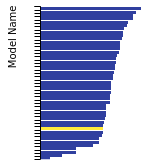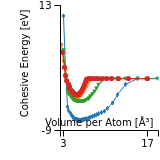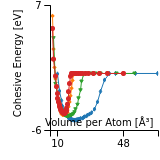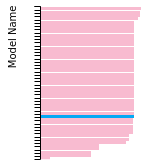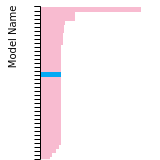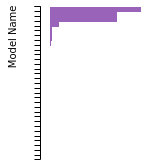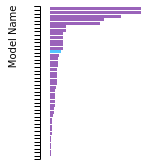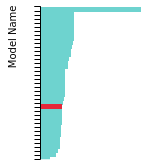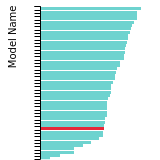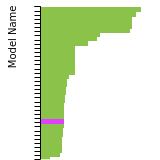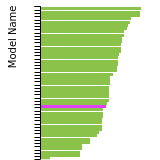Test
Test Results
Link to Test Results page
Benchmark time
Usertime multiplied by the Whetstone Benchmark. This number can be used (approximately) to compare the performance of different models independently of the architecture on which the test was run.
Conjugate gradient relaxation of random finite cluster of Si atoms v003
1200
Conjugate gradient relaxation of random finite cluster of Si atoms v003
1200
Conjugate gradient relaxation of random finite cluster of Si atoms v003
1169
Conjugate gradient relaxation of random finite cluster of Si atoms v003
1137
Conjugate gradient relaxation of random finite cluster of Si atoms v003
1390
Conjugate gradient relaxation of random finite cluster of Si atoms v003
1106
Conjugate gradient relaxation of random finite cluster of Si atoms v003
1169
Conjugate gradient relaxation of random finite cluster of Si atoms v003
1011
Conjugate gradient relaxation of random finite cluster of Si atoms v003
979
Conjugate gradient relaxation of random finite cluster of Si atoms v003
884
Conjugate gradient relaxation of random finite cluster of Si atoms v003
1074
Conjugate gradient relaxation of random finite cluster of Si atoms v003
884
Conjugate gradient relaxation of random finite cluster of Si atoms v003
1137
Conjugate gradient relaxation of random finite cluster of Si atoms v003
790
Conjugate gradient relaxation of random finite cluster of Si atoms v003
979
Conjugate gradient relaxation of random finite cluster of Si atoms v003
1106
Conjugate gradient relaxation of random finite cluster of Si atoms v003
884
Conjugate gradient relaxation of random finite cluster of Si atoms v003
1137
Conjugate gradient relaxation of random finite cluster of Si atoms v003
1200
Conjugate gradient relaxation of random finite cluster of Si atoms v003
1137
Conjugate gradient relaxation of random finite cluster of Si atoms v003
1074
Conjugate gradient relaxation of random finite cluster of Si atoms v003
948
Conjugate gradient relaxation of random finite cluster of Si atoms v003
1169
Conjugate gradient relaxation of random finite cluster of Si atoms v003
979
Conjugate gradient relaxation of random finite cluster of Si atoms v003
1106
Conjugate gradient relaxation of random finite cluster of Si atoms v003
916
Conjugate gradient relaxation of random finite cluster of Si atoms v003
1327
Conjugate gradient relaxation of random finite cluster of Si atoms v003
979
Conjugate gradient relaxation of random finite cluster of Si atoms v003
1264
Conjugate gradient relaxation of random finite cluster of Si atoms v003
1169
Conjugate gradient relaxation of random finite cluster of Si atoms v003
1200
Conjugate gradient relaxation of random finite cluster of Si atoms v003
1169
Conjugate gradient relaxation of random finite cluster of Si atoms v003
1011
Conjugate gradient relaxation of random finite cluster of Si atoms v003
948
Conjugate gradient relaxation of random finite cluster of Si atoms v003
1169
Conjugate gradient relaxation of random finite cluster of Si atoms v003
1516
Conjugate gradient relaxation of random finite cluster of Si atoms v003
1137
Conjugate gradient relaxation of random finite cluster of Si atoms v003
1011
Conjugate gradient relaxation of random finite cluster of Si atoms v003
1137
Conjugate gradient relaxation of random finite cluster of Si atoms v003
1169
Conjugate gradient relaxation of random finite cluster of Si atoms v003
1169
Conjugate gradient relaxation of random finite cluster of Si atoms v003
1264
Conjugate gradient relaxation of random finite cluster of Si atoms v003
1106
Conjugate gradient relaxation of random finite cluster of Si atoms v003
1327
Conjugate gradient relaxation of random finite cluster of Si atoms v003
1042
Conjugate gradient relaxation of random finite cluster of Si atoms v003
1011
Conjugate gradient relaxation of random finite cluster of Si atoms v003
1295
Conjugate gradient relaxation of random finite cluster of Si atoms v003
1327
Conjugate gradient relaxation of random finite cluster of Si atoms v003
916
Conjugate gradient relaxation of random finite cluster of Si atoms v003
1358
Conjugate gradient relaxation of random finite cluster of Si atoms v003
1106
Conjugate gradient relaxation of random finite cluster of Si atoms v003
979
Conjugate gradient relaxation of random finite cluster of Si atoms v003
1200
Conjugate gradient relaxation of random finite cluster of Si atoms v003
1106
Conjugate gradient relaxation of random finite cluster of Si atoms v003
1042
Conjugate gradient relaxation of random finite cluster of Si atoms v003
821
Conjugate gradient relaxation of random finite cluster of Si atoms v003
979
Conjugate gradient relaxation of random finite cluster of Si atoms v003
1011
Conjugate gradient relaxation of random finite cluster of Si atoms v003
948
Conjugate gradient relaxation of random finite cluster of Si atoms v003
1106
Conjugate gradient relaxation of random finite cluster of Si atoms v003
1106
Conjugate gradient relaxation of random finite cluster of Si atoms v003
948
Conjugate gradient relaxation of random finite cluster of Si atoms v003
979
Conjugate gradient relaxation of random finite cluster of Si atoms v003
948
Conjugate gradient relaxation of random finite cluster of Si atoms v003
1042
Conjugate gradient relaxation of random finite cluster of Si atoms v003
1169
Conjugate gradient relaxation of random finite cluster of Si atoms v003
948
Conjugate gradient relaxation of random finite cluster of Si atoms v003
1074
Conjugate gradient relaxation of random finite cluster of Si atoms v003
1327
Conjugate gradient relaxation of random finite cluster of Si atoms v003
948
Conjugate gradient relaxation of random finite cluster of Si atoms v003
1074
Conjugate gradient relaxation of random finite cluster of Si atoms v003
821
Conjugate gradient relaxation of random finite cluster of Si atoms v003
1011
Conjugate gradient relaxation of random finite cluster of Si atoms v003
1169
Conjugate gradient relaxation of random finite cluster of Si atoms v003
1390
Conjugate gradient relaxation of random finite cluster of Si atoms v003
948
Conjugate gradient relaxation of random finite cluster of Si atoms v003
1169
Conjugate gradient relaxation of random finite cluster of Si atoms v003
1422
Conjugate gradient relaxation of random finite cluster of Si atoms v003
1295
Conjugate gradient relaxation of random finite cluster of Si atoms v003
1042
Conjugate gradient relaxation of random finite cluster of Si atoms v003
916
Conjugate gradient relaxation of random finite cluster of Si atoms v003
1074
Conjugate gradient relaxation of random finite cluster of Si atoms v003
853
Conjugate gradient relaxation of random finite cluster of Si atoms v003
1042
Conjugate gradient relaxation of random finite cluster of Si atoms v003
1169
Conjugate gradient relaxation of random finite cluster of Si atoms v003
979
Conjugate gradient relaxation of random finite cluster of Si atoms v003
1106
Conjugate gradient relaxation of random finite cluster of Si atoms v003
948
Conjugate gradient relaxation of random finite cluster of Si atoms v003
1011
Conjugate gradient relaxation of random finite cluster of Si atoms v003
1042
Conjugate gradient relaxation of random finite cluster of Si atoms v003
979
Conjugate gradient relaxation of random finite cluster of Si atoms v003
948
Conjugate gradient relaxation of random finite cluster of Si atoms v003
821
Conjugate gradient relaxation of random finite cluster of Si atoms v003
979
Conjugate gradient relaxation of random finite cluster of Si atoms v003
1232
Conjugate gradient relaxation of random finite cluster of Si atoms v003
1074
Conjugate gradient relaxation of random finite cluster of Si atoms v003
1011
Conjugate gradient relaxation of random finite cluster of Si atoms v003
1200
Conjugate gradient relaxation of random finite cluster of Si atoms v003
1169
Conjugate gradient relaxation of random finite cluster of Si atoms v003
979
Conjugate gradient relaxation of random finite cluster of Si atoms v003
1106
Conjugate gradient relaxation of random finite cluster of Si atoms v003
948
Conjugate gradient relaxation of random finite cluster of Si atoms v003
821
Conjugate gradient relaxation of random finite cluster of Si atoms v003
979
Conjugate gradient relaxation of random finite cluster of Si atoms v003
1264
Conjugate gradient relaxation of random finite cluster of Si atoms v003
1106
Conjugate gradient relaxation of random finite cluster of Si atoms v003
1106
Conjugate gradient relaxation of random finite cluster of Si atoms v003
1011
Conjugate gradient relaxation of random finite cluster of Si atoms v003
821
Conjugate gradient relaxation of random finite cluster of Si atoms v003
1232
Conjugate gradient relaxation of random finite cluster of Si atoms v003
979
Conjugate gradient relaxation of random finite cluster of Si atoms v003
1106
Conjugate gradient relaxation of random finite cluster of Si atoms v003
1137
Conjugate gradient relaxation of random finite cluster of Si atoms v003
853
Conjugate gradient relaxation of random finite cluster of Si atoms v003
1011
Conjugate gradient relaxation of random finite cluster of Si atoms v003
1137
Conjugate gradient relaxation of random finite cluster of Si atoms v003
948
Conjugate gradient relaxation of random finite cluster of Si atoms v003
1042
Conjugate gradient relaxation of random finite cluster of Si atoms v003
1011
Conjugate gradient relaxation of random finite cluster of Si atoms v003
1106
Conjugate gradient relaxation of random finite cluster of Si atoms v003
1264
Conjugate gradient relaxation of random finite cluster of Si atoms v003
948
Conjugate gradient relaxation of random finite cluster of Si atoms v003
1042
Conjugate gradient relaxation of random finite cluster of Si atoms v003
853
Conjugate gradient relaxation of random finite cluster of Si atoms v003
1106
Conjugate gradient relaxation of random finite cluster of Si atoms v003
1042
Conjugate gradient relaxation of random finite cluster of Si atoms v003
1042
Conjugate gradient relaxation of random finite cluster of Si atoms v003
916
Conjugate gradient relaxation of random finite cluster of Si atoms v003
1042
Conjugate gradient relaxation of random finite cluster of Si atoms v003
727
Conjugate gradient relaxation of random finite cluster of Si atoms v003
1042
Conjugate gradient relaxation of random finite cluster of Si atoms v003
727
Conjugate gradient relaxation of random finite cluster of Si atoms v003
853
Conjugate gradient relaxation of random finite cluster of Si atoms v003
1011
Conjugate gradient relaxation of random finite cluster of Si atoms v003
821
Conjugate gradient relaxation of random finite cluster of Si atoms v003
1137
Conjugate gradient relaxation of random finite cluster of Si atoms v003
1137
Conjugate gradient relaxation of random finite cluster of Si atoms v003
1074
Conjugate gradient relaxation of random finite cluster of Si atoms v003
1358
Conjugate gradient relaxation of random finite cluster of Si atoms v003
853
Conjugate gradient relaxation of random finite cluster of Si atoms v003
884
Conjugate gradient relaxation of random finite cluster of Si atoms v003
1169
Conjugate gradient relaxation of random finite cluster of Si atoms v003
1327
Conjugate gradient relaxation of random finite cluster of Si atoms v003
1011
Conjugate gradient relaxation of random finite cluster of Si atoms v003
1200
Conjugate gradient relaxation of random finite cluster of Si atoms v003
1011
Conjugate gradient relaxation of random finite cluster of Si atoms v003
1011
Conjugate gradient relaxation of random finite cluster of Si atoms v003
948
Conjugate gradient relaxation of random finite cluster of Si atoms v003
1042
Conjugate gradient relaxation of random finite cluster of Si atoms v003
1232
Conjugate gradient relaxation of random finite cluster of Si atoms v003
1106
Conjugate gradient relaxation of random finite cluster of Si atoms v003
1137
Conjugate gradient relaxation of random finite cluster of Si atoms v003
1011
Conjugate gradient relaxation of random finite cluster of Si atoms v003
1232
Conjugate gradient relaxation of random finite cluster of Si atoms v003
1106
Conjugate gradient relaxation of random finite cluster of Si atoms v003
1074
Conjugate gradient relaxation of random finite cluster of Si atoms v003
979
Conjugate gradient relaxation of random finite cluster of Si atoms v003
1264
Conjugate gradient relaxation of random finite cluster of Si atoms v003
1232
Conjugate gradient relaxation of random finite cluster of Si atoms v003
1011
Conjugate gradient relaxation of random finite cluster of Si atoms v003
1264
Conjugate gradient relaxation of random finite cluster of Si atoms v003
1264
Conjugate gradient relaxation of random finite cluster of Si atoms v003
1074
Conjugate gradient relaxation of random finite cluster of Si atoms v003
884
Conjugate gradient relaxation of random finite cluster of Si atoms v003
1074
Conjugate gradient relaxation of random finite cluster of Si atoms v003
1074
Conjugate gradient relaxation of random finite cluster of Si atoms v003
1011
Conjugate gradient relaxation of random finite cluster of Si atoms v003
1074
Conjugate gradient relaxation of random finite cluster of Si atoms v003
1137
Conjugate gradient relaxation of random finite cluster of Si atoms v003
1169
Conjugate gradient relaxation of random finite cluster of Si atoms v003
1358
Conjugate gradient relaxation of random finite cluster of Si atoms v003
1295
Conjugate gradient relaxation of random finite cluster of Si atoms v003
1042
Conjugate gradient relaxation of random finite cluster of Si atoms v003
1074
Conjugate gradient relaxation of random finite cluster of Si atoms v003
1042
Conjugate gradient relaxation of random finite cluster of Si atoms v003
916
Conjugate gradient relaxation of random finite cluster of Si atoms v003
853
Conjugate gradient relaxation of random finite cluster of Si atoms v003
1358
Conjugate gradient relaxation of random finite cluster of Si atoms v003
979
Conjugate gradient relaxation of random finite cluster of Si atoms v003
1106
Conjugate gradient relaxation of random finite cluster of Si atoms v003
979
Conjugate gradient relaxation of random finite cluster of Si atoms v003
979
Conjugate gradient relaxation of random finite cluster of Si atoms v003
1106
Conjugate gradient relaxation of random finite cluster of Si atoms v003
821
Conjugate gradient relaxation of random finite cluster of Si atoms v003
1137
Conjugate gradient relaxation of random finite cluster of Si atoms v003
916
Conjugate gradient relaxation of random finite cluster of Si atoms v003
1042
Conjugate gradient relaxation of random finite cluster of Si atoms v003
979
Conjugate gradient relaxation of random finite cluster of Si atoms v003
821
Conjugate gradient relaxation of random finite cluster of Si atoms v003
1042
Conjugate gradient relaxation of random finite cluster of Si atoms v003
758
Conjugate gradient relaxation of random finite cluster of Si atoms v003
1137
Conjugate gradient relaxation of random finite cluster of Si atoms v003
1327
Conjugate gradient relaxation of random finite cluster of Si atoms v003
979
Conjugate gradient relaxation of random finite cluster of Si atoms v003
884
Conjugate gradient relaxation of random finite cluster of Si atoms v003
1011
Conjugate gradient relaxation of random finite cluster of Si atoms v003
1200
Conjugate gradient relaxation of random finite cluster of Si atoms v003
853
Conjugate gradient relaxation of random finite cluster of Si atoms v003
1042
Conjugate gradient relaxation of random finite cluster of Si atoms v003
1042
Conjugate gradient relaxation of random finite cluster of Si atoms v003
1011
Conjugate gradient relaxation of random finite cluster of Si atoms v003
1011
Conjugate gradient relaxation of random finite cluster of Si atoms v003
1074
Conjugate gradient relaxation of random finite cluster of Si atoms v003
1074
Conjugate gradient relaxation of random finite cluster of Si atoms v003
916
Conjugate gradient relaxation of random finite cluster of Si atoms v003
1232
Conjugate gradient relaxation of random finite cluster of Si atoms v003
1074
Conjugate gradient relaxation of random finite cluster of Si atoms v003
979
Conjugate gradient relaxation of random finite cluster of Si atoms v003
1169
Conjugate gradient relaxation of random finite cluster of Si atoms v003
979
Conjugate gradient relaxation of random finite cluster of Si atoms v003
979
Conjugate gradient relaxation of random finite cluster of Si atoms v003
853
Conjugate gradient relaxation of random finite cluster of Si atoms v003
1137
Conjugate gradient relaxation of random finite cluster of Si atoms v003
821
Conjugate gradient relaxation of random finite cluster of Si atoms v003
821
Conjugate gradient relaxation of random finite cluster of Si atoms v003
979
Conjugate gradient relaxation of random finite cluster of Si atoms v003
1169
Conjugate gradient relaxation of random finite cluster of Si atoms v003
1074
Conjugate gradient relaxation of random finite cluster of Si atoms v003
1264
Conjugate gradient relaxation of random finite cluster of Si atoms v003
1011
Conjugate gradient relaxation of random finite cluster of Si atoms v003
1074
Conjugate gradient relaxation of random finite cluster of Si atoms v003
1106
Conjugate gradient relaxation of random finite cluster of Si atoms v003
979
Conjugate gradient relaxation of random finite cluster of Si atoms v003
979
Conjugate gradient relaxation of random finite cluster of Si atoms v003
1074
Conjugate gradient relaxation of random finite cluster of Si atoms v003
1106
Conjugate gradient relaxation of random finite cluster of Si atoms v003
1042
Conjugate gradient relaxation of random finite cluster of Si atoms v003
1042
Conjugate gradient relaxation of random finite cluster of Si atoms v003
916
Conjugate gradient relaxation of random finite cluster of Si atoms v003
948
Conjugate gradient relaxation of random finite cluster of Si atoms v003
979
Conjugate gradient relaxation of random finite cluster of Si atoms v003
916
Conjugate gradient relaxation of random finite cluster of Si atoms v003
727
Conjugate gradient relaxation of random finite cluster of Si atoms v003
1200
Conjugate gradient relaxation of random finite cluster of Si atoms v003
916
Conjugate gradient relaxation of random finite cluster of Si atoms v003
1264
Conjugate gradient relaxation of random finite cluster of Si atoms v003
1042
Conjugate gradient relaxation of random finite cluster of Si atoms v003
1200
Conjugate gradient relaxation of random finite cluster of Si atoms v003
916
Conjugate gradient relaxation of random finite cluster of Si atoms v003
853
Conjugate gradient relaxation of random finite cluster of Si atoms v003
979
Conjugate gradient relaxation of random finite cluster of Si atoms v003
1106
Conjugate gradient relaxation of random finite cluster of Si atoms v003
1169
Conjugate gradient relaxation of random finite cluster of Si atoms v003
979
Conjugate gradient relaxation of random finite cluster of Si atoms v003
1106
Conjugate gradient relaxation of random finite cluster of Si atoms v003
1137
Conjugate gradient relaxation of random finite cluster of Si atoms v003
916
Conjugate gradient relaxation of random finite cluster of Si atoms v003
1042
Conjugate gradient relaxation of random finite cluster of Si atoms v003
1042
Conjugate gradient relaxation of random finite cluster of Si atoms v003
1200
Conjugate gradient relaxation of random finite cluster of Si atoms v003
1011
Conjugate gradient relaxation of random finite cluster of Si atoms v003
1106
Conjugate gradient relaxation of random finite cluster of Si atoms v003
1295
Conjugate gradient relaxation of random finite cluster of Si atoms v003
979
Conjugate gradient relaxation of random finite cluster of Si atoms v003
1232
Conjugate gradient relaxation of random finite cluster of Si atoms v003
1106
Conjugate gradient relaxation of random finite cluster of Si atoms v003
1137
Conjugate gradient relaxation of random finite cluster of Si atoms v003
1200
Conjugate gradient relaxation of random finite cluster of Si atoms v003
916
Conjugate gradient relaxation of random finite cluster of Si atoms v003
1169
Conjugate gradient relaxation of random finite cluster of Si atoms v003
884
Conjugate gradient relaxation of random finite cluster of Si atoms v003
1042
Conjugate gradient relaxation of random finite cluster of Si atoms v003
979
Conjugate gradient relaxation of random finite cluster of Si atoms v003
1169
Conjugate gradient relaxation of random finite cluster of Si atoms v003
790
Conjugate gradient relaxation of random finite cluster of Si atoms v003
1232
Conjugate gradient relaxation of random finite cluster of Si atoms v003
916
Conjugate gradient relaxation of random finite cluster of Si atoms v003
1169
Conjugate gradient relaxation of random finite cluster of Si atoms v003
1137
Conjugate gradient relaxation of random finite cluster of Si atoms v003
1074
Conjugate gradient relaxation of random finite cluster of Si atoms v003
1106
Conjugate gradient relaxation of random finite cluster of Si atoms v003
884
Conjugate gradient relaxation of random finite cluster of Si atoms v003
979
Conjugate gradient relaxation of random finite cluster of Si atoms v003
1074
Conjugate gradient relaxation of random finite cluster of Si atoms v003
1169
Conjugate gradient relaxation of random finite cluster of Si atoms v003
1106
Conjugate gradient relaxation of random finite cluster of Si atoms v003
1169
Conjugate gradient relaxation of random finite cluster of Si atoms v003
948
Conjugate gradient relaxation of random finite cluster of Si atoms v003
1042
Conjugate gradient relaxation of random finite cluster of Si atoms v003
1042
Conjugate gradient relaxation of random finite cluster of Si atoms v003
1264
Conjugate gradient relaxation of random finite cluster of Si atoms v003
821
Conjugate gradient relaxation of random finite cluster of Si atoms v003
1327
Conjugate gradient relaxation of random finite cluster of Si atoms v003
1232
Conjugate gradient relaxation of random finite cluster of Si atoms v003
1137
Conjugate gradient relaxation of random finite cluster of Si atoms v003
1169
Conjugate gradient relaxation of random finite cluster of Si atoms v003
884
Conjugate gradient relaxation of random finite cluster of Si atoms v003
790
Conjugate gradient relaxation of random finite cluster of Si atoms v003
1074
Conjugate gradient relaxation of random finite cluster of Si atoms v003
948
Conjugate gradient relaxation of random finite cluster of Si atoms v003
1074
Conjugate gradient relaxation of random finite cluster of Si atoms v003
1232
Conjugate gradient relaxation of random finite cluster of Si atoms v003
916
Conjugate gradient relaxation of random finite cluster of Si atoms v003
1011
Conjugate gradient relaxation of random finite cluster of Si atoms v003
1106
Conjugate gradient relaxation of random finite cluster of Si atoms v003
948
Conjugate gradient relaxation of random finite cluster of Si atoms v003
979
Conjugate gradient relaxation of random finite cluster of Si atoms v003
916
Conjugate gradient relaxation of random finite cluster of Si atoms v003
1137
Conjugate gradient relaxation of random finite cluster of Si atoms v003
853
Conjugate gradient relaxation of random finite cluster of Si atoms v003
979
Conjugate gradient relaxation of random finite cluster of Si atoms v003
1295
Conjugate gradient relaxation of random finite cluster of Si atoms v003
884
Conjugate gradient relaxation of random finite cluster of Si atoms v003
1042
Conjugate gradient relaxation of random finite cluster of Si atoms v003
1137
Conjugate gradient relaxation of random finite cluster of Si atoms v003
1042
Conjugate gradient relaxation of random finite cluster of Si atoms v003
1264
Conjugate gradient relaxation of random finite cluster of Si atoms v003
916
Conjugate gradient relaxation of random finite cluster of Si atoms v003
1011
Conjugate gradient relaxation of random finite cluster of Si atoms v003
1011
Conjugate gradient relaxation of random finite cluster of Si atoms v003
1137
Conjugate gradient relaxation of random finite cluster of Si atoms v003
948
Conjugate gradient relaxation of random finite cluster of Si atoms v003
1042
Conjugate gradient relaxation of random finite cluster of Si atoms v003
821
Conjugate gradient relaxation of random finite cluster of Si atoms v003
948
Conjugate gradient relaxation of random finite cluster of Si atoms v003
1011
Conjugate gradient relaxation of random finite cluster of Si atoms v003
1042
Conjugate gradient relaxation of random finite cluster of Si atoms v003
1169
Conjugate gradient relaxation of random finite cluster of Si atoms v003
1106
Conjugate gradient relaxation of random finite cluster of Si atoms v003
884
Conjugate gradient relaxation of random finite cluster of Si atoms v003
948
Conjugate gradient relaxation of random finite cluster of Si atoms v003
1074
Conjugate gradient relaxation of random finite cluster of Si atoms v003
1042
Conjugate gradient relaxation of random finite cluster of Si atoms v003
1042
Conjugate gradient relaxation of random finite cluster of Si atoms v003
1106
Conjugate gradient relaxation of random finite cluster of Si atoms v003
948
Conjugate gradient relaxation of random finite cluster of Si atoms v003
1011
Conjugate gradient relaxation of random finite cluster of Si atoms v003
1042
Conjugate gradient relaxation of random finite cluster of Si atoms v003
1106
Conjugate gradient relaxation of random finite cluster of Si atoms v003
853
Conjugate gradient relaxation of random finite cluster of Si atoms v003
1264
Conjugate gradient relaxation of random finite cluster of Si atoms v003
1011
Conjugate gradient relaxation of random finite cluster of Si atoms v003
1042
Conjugate gradient relaxation of random finite cluster of Si atoms v003
1074
Conjugate gradient relaxation of random finite cluster of Si atoms v003
1042
Conjugate gradient relaxation of random finite cluster of Si atoms v003
1042
Conjugate gradient relaxation of random finite cluster of Si atoms v003
1042
Conjugate gradient relaxation of random finite cluster of Si atoms v003
1169
Conjugate gradient relaxation of random finite cluster of Si atoms v003
1169
Conjugate gradient relaxation of random finite cluster of Si atoms v003
1042
Conjugate gradient relaxation of random finite cluster of Si atoms v003
821
Conjugate gradient relaxation of random finite cluster of Si atoms v003
1232
Conjugate gradient relaxation of random finite cluster of Si atoms v003
1422
Conjugate gradient relaxation of random finite cluster of Si atoms v003
1074
Conjugate gradient relaxation of random finite cluster of Si atoms v003
1011
Conjugate gradient relaxation of random finite cluster of Si atoms v003
1232
Conjugate gradient relaxation of random finite cluster of Si atoms v003
979
Conjugate gradient relaxation of random finite cluster of Si atoms v003
853
Conjugate gradient relaxation of random finite cluster of Si atoms v003
1042
Conjugate gradient relaxation of random finite cluster of Si atoms v003
1042
Conjugate gradient relaxation of random finite cluster of Si atoms v003
1358
Conjugate gradient relaxation of random finite cluster of Si atoms v003
1106
Conjugate gradient relaxation of random finite cluster of Si atoms v003
979
Conjugate gradient relaxation of random finite cluster of Si atoms v003
979
Conjugate gradient relaxation of random finite cluster of Si atoms v003
1169
Conjugate gradient relaxation of random finite cluster of Si atoms v003
1074
Conjugate gradient relaxation of random finite cluster of Si atoms v003
1011
Conjugate gradient relaxation of random finite cluster of Si atoms v003
1074
Conjugate gradient relaxation of random finite cluster of Si atoms v003
916
Conjugate gradient relaxation of random finite cluster of Si atoms v003
916
Conjugate gradient relaxation of random finite cluster of Si atoms v003
1106
Conjugate gradient relaxation of random finite cluster of Si atoms v003
1169
Conjugate gradient relaxation of random finite cluster of Si atoms v003
1106
Conjugate gradient relaxation of random finite cluster of Si atoms v003
1042
Conjugate gradient relaxation of random finite cluster of Si atoms v003
1042
Conjugate gradient relaxation of random finite cluster of Si atoms v003
1137
Conjugate gradient relaxation of random finite cluster of Si atoms v003
1106
Conjugate gradient relaxation of random finite cluster of Si atoms v003
979
Conjugate gradient relaxation of random finite cluster of Si atoms v003
1295
Conjugate gradient relaxation of random finite cluster of Si atoms v003
1074
Conjugate gradient relaxation of random finite cluster of Si atoms v003
1264
Conjugate gradient relaxation of random finite cluster of Si atoms v003
1106
Conjugate gradient relaxation of random finite cluster of Si atoms v003
979
Conjugate gradient relaxation of random finite cluster of Si atoms v003
916
Conjugate gradient relaxation of random finite cluster of Si atoms v003
1106
Conjugate gradient relaxation of random finite cluster of Si atoms v003
1106
Conjugate gradient relaxation of random finite cluster of Si atoms v003
884
Conjugate gradient relaxation of random finite cluster of Si atoms v003
1264
Conjugate gradient relaxation of random finite cluster of Si atoms v003
727
Conjugate gradient relaxation of random finite cluster of Si atoms v003
979
Conjugate gradient relaxation of random finite cluster of Si atoms v003
1074
Conjugate gradient relaxation of random finite cluster of Si atoms v003
758
Conjugate gradient relaxation of random finite cluster of Si atoms v003
1169
Conjugate gradient relaxation of random finite cluster of Si atoms v003
1042
Conjugate gradient relaxation of random finite cluster of Si atoms v003
1200
Conjugate gradient relaxation of random finite cluster of Si atoms v003
948
Conjugate gradient relaxation of random finite cluster of Si atoms v003
1106
Conjugate gradient relaxation of random finite cluster of Si atoms v003
1011
Conjugate gradient relaxation of random finite cluster of Si atoms v003
1295
Conjugate gradient relaxation of random finite cluster of Si atoms v003
1106
Conjugate gradient relaxation of random finite cluster of Si atoms v003
1264
Conjugate gradient relaxation of random finite cluster of Si atoms v003
1295
Conjugate gradient relaxation of random finite cluster of Si atoms v003
1106
Conjugate gradient relaxation of random finite cluster of Si atoms v003
948
Conjugate gradient relaxation of random finite cluster of Si atoms v003
1011
Conjugate gradient relaxation of random finite cluster of Si atoms v003
1169
Conjugate gradient relaxation of random finite cluster of Si atoms v003
1169
Conjugate gradient relaxation of random finite cluster of Si atoms v003
1232
Conjugate gradient relaxation of random finite cluster of Si atoms v003
1137
Conjugate gradient relaxation of random finite cluster of Si atoms v003
1011
Conjugate gradient relaxation of random finite cluster of Si atoms v003
1485
Conjugate gradient relaxation of random finite cluster of Si atoms v003
1106
Conjugate gradient relaxation of random finite cluster of Si atoms v003
916
Conjugate gradient relaxation of random finite cluster of Si atoms v003
1042
Conjugate gradient relaxation of random finite cluster of Si atoms v003
1137
Conjugate gradient relaxation of random finite cluster of Si atoms v003
1042
Conjugate gradient relaxation of random finite cluster of Si atoms v003
979
Conjugate gradient relaxation of random finite cluster of Si atoms v003
1264
Conjugate gradient relaxation of random finite cluster of Si atoms v003
1074
Conjugate gradient relaxation of random finite cluster of Si atoms v003
1074
Conjugate gradient relaxation of random finite cluster of Si atoms v003
1232
Conjugate gradient relaxation of random finite cluster of Si atoms v003
1453
Conjugate gradient relaxation of random finite cluster of Si atoms v003
821
Conjugate gradient relaxation of random finite cluster of Si atoms v003
1169
Conjugate gradient relaxation of random finite cluster of Si atoms v003
948
Conjugate gradient relaxation of random finite cluster of Si atoms v003
948
Conjugate gradient relaxation of random finite cluster of Si atoms v003
1137
Conjugate gradient relaxation of random finite cluster of Si atoms v003
1042
Conjugate gradient relaxation of random finite cluster of Si atoms v003
1358
Conjugate gradient relaxation of random finite cluster of Si atoms v003
695
Conjugate gradient relaxation of random finite cluster of Si atoms v003
1200
Conjugate gradient relaxation of random finite cluster of Si atoms v003
1169
Conjugate gradient relaxation of random finite cluster of Si atoms v003
1074
Conjugate gradient relaxation of random finite cluster of Si atoms v003
1011
Conjugate gradient relaxation of random finite cluster of Si atoms v003
1042
Conjugate gradient relaxation of random finite cluster of Si atoms v003
1200
Conjugate gradient relaxation of random finite cluster of Si atoms v003
1042
Conjugate gradient relaxation of random finite cluster of Si atoms v003
979
Conjugate gradient relaxation of random finite cluster of Si atoms v003
1327
Conjugate gradient relaxation of random finite cluster of Si atoms v003
1264
Conjugate gradient relaxation of random finite cluster of Si atoms v003
1011
Conjugate gradient relaxation of random finite cluster of Si atoms v003
1137
Conjugate gradient relaxation of random finite cluster of Si atoms v003
1106
Conjugate gradient relaxation of random finite cluster of Si atoms v003
1011
Conjugate gradient relaxation of random finite cluster of Si atoms v003
1011
Conjugate gradient relaxation of random finite cluster of Si atoms v003
1200
Conjugate gradient relaxation of random finite cluster of Si atoms v003
1011
Conjugate gradient relaxation of random finite cluster of Si atoms v003
979
Conjugate gradient relaxation of random finite cluster of Si atoms v003
1042
Conjugate gradient relaxation of random finite cluster of Si atoms v003
1232
Conjugate gradient relaxation of random finite cluster of Si atoms v003
758
Conjugate gradient relaxation of random finite cluster of Si atoms v003
979
Conjugate gradient relaxation of random finite cluster of Si atoms v003
884
Conjugate gradient relaxation of random finite cluster of Si atoms v003
790
Conjugate gradient relaxation of random finite cluster of Si atoms v003
1264
Conjugate gradient relaxation of random finite cluster of Si atoms v003
1106
Conjugate gradient relaxation of random finite cluster of Si atoms v003
1011
Conjugate gradient relaxation of random finite cluster of Si atoms v003
1327
Conjugate gradient relaxation of random finite cluster of Si atoms v003
884
Conjugate gradient relaxation of random finite cluster of Si atoms v003
1232
Conjugate gradient relaxation of random finite cluster of Si atoms v003
1169
Conjugate gradient relaxation of random finite cluster of Si atoms v003
1011
Conjugate gradient relaxation of random finite cluster of Si atoms v003
948
Conjugate gradient relaxation of random finite cluster of Si atoms v003
916
Conjugate gradient relaxation of random finite cluster of Si atoms v003
1042
Conjugate gradient relaxation of random finite cluster of Si atoms v003
948
Conjugate gradient relaxation of random finite cluster of Si atoms v003
853
Conjugate gradient relaxation of random finite cluster of Si atoms v003
916
Conjugate gradient relaxation of random finite cluster of Si atoms v003
1200
Conjugate gradient relaxation of random finite cluster of Si atoms v003
1011
Conjugate gradient relaxation of random finite cluster of Si atoms v003
1137
Conjugate gradient relaxation of random finite cluster of Si atoms v003
1074
Conjugate gradient relaxation of random finite cluster of Si atoms v003
1169
Conjugate gradient relaxation of random finite cluster of Si atoms v003
1327
Conjugate gradient relaxation of random finite cluster of Si atoms v003
948
Conjugate gradient relaxation of random finite cluster of Si atoms v003
1295
Conjugate gradient relaxation of random finite cluster of Si atoms v003
1011
Conjugate gradient relaxation of random finite cluster of Si atoms v003
884
Conjugate gradient relaxation of random finite cluster of Si atoms v003
948
Conjugate gradient relaxation of random finite cluster of Si atoms v003
1074
Conjugate gradient relaxation of random finite cluster of Si atoms v003
1137
Conjugate gradient relaxation of random finite cluster of Si atoms v003
884
Conjugate gradient relaxation of random finite cluster of Si atoms v003
853
Conjugate gradient relaxation of random finite cluster of Si atoms v003
884
Conjugate gradient relaxation of random finite cluster of Si atoms v003
916
Conjugate gradient relaxation of random finite cluster of Si atoms v003
1074
Conjugate gradient relaxation of random finite cluster of Si atoms v003
1169
Conjugate gradient relaxation of random finite cluster of Si atoms v003
1074
Conjugate gradient relaxation of random finite cluster of Si atoms v003
1358
Conjugate gradient relaxation of random finite cluster of Si atoms v003
1074
Conjugate gradient relaxation of random finite cluster of Si atoms v003
1074
Conjugate gradient relaxation of random finite cluster of Si atoms v003
1327
Conjugate gradient relaxation of random finite cluster of Si atoms v003
916
Conjugate gradient relaxation of random finite cluster of Si atoms v003
1264
Conjugate gradient relaxation of random finite cluster of Si atoms v003
979
Conjugate gradient relaxation of random finite cluster of Si atoms v003
1106
Conjugate gradient relaxation of random finite cluster of Si atoms v003
1074
Conjugate gradient relaxation of random finite cluster of Si atoms v003
979
Conjugate gradient relaxation of random finite cluster of Si atoms v003
1074
Conjugate gradient relaxation of random finite cluster of Si atoms v003
1106
Conjugate gradient relaxation of random finite cluster of Si atoms v003
979
Conjugate gradient relaxation of random finite cluster of Si atoms v003
1011
Conjugate gradient relaxation of random finite cluster of Si atoms v003
1106
Conjugate gradient relaxation of random finite cluster of Si atoms v003
884
Conjugate gradient relaxation of random finite cluster of Si atoms v003
1042
Conjugate gradient relaxation of random finite cluster of Si atoms v003
948
Conjugate gradient relaxation of random finite cluster of Si atoms v003
1169
Conjugate gradient relaxation of random finite cluster of Si atoms v003
790
Conjugate gradient relaxation of random finite cluster of Si atoms v003
916
Conjugate gradient relaxation of random finite cluster of Si atoms v003
1232
Conjugate gradient relaxation of random finite cluster of Si atoms v003
979
Conjugate gradient relaxation of random finite cluster of Si atoms v003
1137
Conjugate gradient relaxation of random finite cluster of Si atoms v003
1169
Conjugate gradient relaxation of random finite cluster of Si atoms v003
1106
Conjugate gradient relaxation of random finite cluster of Si atoms v003
1011
Conjugate gradient relaxation of random finite cluster of Si atoms v003
948
Conjugate gradient relaxation of random finite cluster of Si atoms v003
1011
Conjugate gradient relaxation of random finite cluster of Si atoms v003
884
Conjugate gradient relaxation of random finite cluster of Si atoms v003
1200
Conjugate gradient relaxation of random finite cluster of Si atoms v003
1106
Conjugate gradient relaxation of random finite cluster of Si atoms v003
1011
Conjugate gradient relaxation of random finite cluster of Si atoms v003
1137
Conjugate gradient relaxation of random finite cluster of Si atoms v003
853
Conjugate gradient relaxation of random finite cluster of Si atoms v003
1106
Conjugate gradient relaxation of random finite cluster of Si atoms v003
1042
Conjugate gradient relaxation of random finite cluster of Si atoms v003
1106
Conjugate gradient relaxation of random finite cluster of Si atoms v003
1232
Conjugate gradient relaxation of random finite cluster of Si atoms v003
1011
Conjugate gradient relaxation of random finite cluster of Si atoms v003
884
Conjugate gradient relaxation of random finite cluster of Si atoms v003
1074
Conjugate gradient relaxation of random finite cluster of Si atoms v003
1042
Conjugate gradient relaxation of random finite cluster of Si atoms v003
1011
Conjugate gradient relaxation of random finite cluster of Si atoms v003
1042
Conjugate gradient relaxation of random finite cluster of Si atoms v003
1074
Conjugate gradient relaxation of random finite cluster of Si atoms v003
1232
Conjugate gradient relaxation of random finite cluster of Si atoms v003
1011
Conjugate gradient relaxation of random finite cluster of Si atoms v003
1011
Conjugate gradient relaxation of random finite cluster of Si atoms v003
853
Conjugate gradient relaxation of random finite cluster of Si atoms v003
1169
Conjugate gradient relaxation of random finite cluster of Si atoms v003
1011
Conjugate gradient relaxation of random finite cluster of Si atoms v003
948
Conjugate gradient relaxation of random finite cluster of Si atoms v003
1042
Conjugate gradient relaxation of random finite cluster of Si atoms v003
948
Conjugate gradient relaxation of random finite cluster of Si atoms v003
1200
Conjugate gradient relaxation of random finite cluster of Si atoms v003
1042
Conjugate gradient relaxation of random finite cluster of Si atoms v003
1264
Conjugate gradient relaxation of random finite cluster of Si atoms v003
1169
Conjugate gradient relaxation of random finite cluster of Si atoms v003
916
Conjugate gradient relaxation of random finite cluster of Si atoms v003
979
Conjugate gradient relaxation of random finite cluster of Si atoms v003
1169
Conjugate gradient relaxation of random finite cluster of Si atoms v003
1390
Conjugate gradient relaxation of random finite cluster of Si atoms v003
916
Conjugate gradient relaxation of random finite cluster of Si atoms v003
1042
Conjugate gradient relaxation of random finite cluster of Si atoms v003
1232
Conjugate gradient relaxation of random finite cluster of Si atoms v003
1137
Conjugate gradient relaxation of random finite cluster of Si atoms v003
1169
Conjugate gradient relaxation of random finite cluster of Si atoms v003
1042
Conjugate gradient relaxation of random finite cluster of Si atoms v003
1232
Conjugate gradient relaxation of random finite cluster of Si atoms v003
1042
Conjugate gradient relaxation of random finite cluster of Si atoms v003
1106
Conjugate gradient relaxation of random finite cluster of Si atoms v003
1042
Conjugate gradient relaxation of random finite cluster of Si atoms v003
1011
Conjugate gradient relaxation of random finite cluster of Si atoms v003
979
Conjugate gradient relaxation of random finite cluster of Si atoms v003
916
Conjugate gradient relaxation of random finite cluster of Si atoms v003
979
Conjugate gradient relaxation of random finite cluster of Si atoms v003
1106
Conjugate gradient relaxation of random finite cluster of Si atoms v003
884
Conjugate gradient relaxation of random finite cluster of Si atoms v003
1011
Conjugate gradient relaxation of random finite cluster of Si atoms v003
1390
Conjugate gradient relaxation of random finite cluster of Si atoms v003
1169
Conjugate gradient relaxation of random finite cluster of Si atoms v003
1074
Conjugate gradient relaxation of random finite cluster of Si atoms v003
1295
Conjugate gradient relaxation of random finite cluster of Si atoms v003
1232
Conjugate gradient relaxation of random finite cluster of Si atoms v003
1200
Conjugate gradient relaxation of random finite cluster of Si atoms v003
979
Conjugate gradient relaxation of random finite cluster of Si atoms v003
1200
Conjugate gradient relaxation of random finite cluster of Si atoms v003
1011
Conjugate gradient relaxation of random finite cluster of Si atoms v003
1295
Conjugate gradient relaxation of random finite cluster of Si atoms v003
1074
Conjugate gradient relaxation of random finite cluster of Si atoms v003
948
Conjugate gradient relaxation of random finite cluster of Si atoms v003
1200
Conjugate gradient relaxation of random finite cluster of Si atoms v003
853
Conjugate gradient relaxation of random finite cluster of Si atoms v003
1042
Conjugate gradient relaxation of random finite cluster of Si atoms v003
1106
Conjugate gradient relaxation of random finite cluster of Si atoms v003
1011
Conjugate gradient relaxation of random finite cluster of Si atoms v003
1042
Conjugate gradient relaxation of random finite cluster of Si atoms v003
979
Conjugate gradient relaxation of random finite cluster of Si atoms v003
948
Conjugate gradient relaxation of random finite cluster of Si atoms v003
884
Conjugate gradient relaxation of random finite cluster of Si atoms v003
1169
Conjugate gradient relaxation of random finite cluster of Si atoms v003
853
Conjugate gradient relaxation of random finite cluster of Si atoms v003
1295
Conjugate gradient relaxation of random finite cluster of Si atoms v003
1011
Conjugate gradient relaxation of random finite cluster of Si atoms v003
1074
Conjugate gradient relaxation of random finite cluster of Si atoms v003
1232
Conjugate gradient relaxation of random finite cluster of Si atoms v003
1137
Conjugate gradient relaxation of random finite cluster of Si atoms v003
1232
Conjugate gradient relaxation of random finite cluster of Si atoms v003
1137
Conjugate gradient relaxation of random finite cluster of Si atoms v003
1169
Conjugate gradient relaxation of random finite cluster of Si atoms v003
1137
Conjugate gradient relaxation of random finite cluster of Si atoms v003
884
Conjugate gradient relaxation of random finite cluster of Si atoms v003
1137
Conjugate gradient relaxation of random finite cluster of Si atoms v003
1200
Conjugate gradient relaxation of random finite cluster of Si atoms v003
1042
Conjugate gradient relaxation of random finite cluster of Si atoms v003
1169
Conjugate gradient relaxation of random finite cluster of Si atoms v003
916
Conjugate gradient relaxation of random finite cluster of Si atoms v003
1106
Conjugate gradient relaxation of random finite cluster of Si atoms v003
1042
Conjugate gradient relaxation of random finite cluster of Si atoms v003
884
Conjugate gradient relaxation of random finite cluster of Si atoms v003
884
Conjugate gradient relaxation of random finite cluster of Si atoms v003
1232
Conjugate gradient relaxation of random finite cluster of Si atoms v003
1232
Conjugate gradient relaxation of random finite cluster of Si atoms v003
1074
Conjugate gradient relaxation of random finite cluster of Si atoms v003
1137
Conjugate gradient relaxation of random finite cluster of Si atoms v003
1264
Conjugate gradient relaxation of random finite cluster of Si atoms v003
948
Conjugate gradient relaxation of random finite cluster of Si atoms v003
1106
Conjugate gradient relaxation of random finite cluster of Si atoms v003
1074
Conjugate gradient relaxation of random finite cluster of Si atoms v003
979
Conjugate gradient relaxation of random finite cluster of Si atoms v003
1042
Conjugate gradient relaxation of random finite cluster of Si atoms v003
979
Conjugate gradient relaxation of random finite cluster of Si atoms v003
1200
Conjugate gradient relaxation of random finite cluster of Si atoms v003
884
Conjugate gradient relaxation of random finite cluster of Si atoms v003
1042
Conjugate gradient relaxation of random finite cluster of Si atoms v003
1264
Conjugate gradient relaxation of random finite cluster of Si atoms v003
1106
Conjugate gradient relaxation of random finite cluster of Si atoms v003
1200
Conjugate gradient relaxation of random finite cluster of Si atoms v003
758
Conjugate gradient relaxation of random finite cluster of Si atoms v003
979
Conjugate gradient relaxation of random finite cluster of Si atoms v003
1042
Conjugate gradient relaxation of random finite cluster of Si atoms v003
1137
Conjugate gradient relaxation of random finite cluster of Si atoms v003
727
Conjugate gradient relaxation of random finite cluster of Si atoms v003
1137
Conjugate gradient relaxation of random finite cluster of Si atoms v003
1011
Conjugate gradient relaxation of random finite cluster of Si atoms v003
948
Conjugate gradient relaxation of random finite cluster of Si atoms v003
1358
Conjugate gradient relaxation of random finite cluster of Si atoms v003
1137
Conjugate gradient relaxation of random finite cluster of Si atoms v003
1106
Conjugate gradient relaxation of random finite cluster of Si atoms v003
979
Conjugate gradient relaxation of random finite cluster of Si atoms v003
1200
Conjugate gradient relaxation of random finite cluster of Si atoms v003
1137
Conjugate gradient relaxation of random finite cluster of Si atoms v003
1137
Conjugate gradient relaxation of random finite cluster of Si atoms v003
1106
Conjugate gradient relaxation of random finite cluster of Si atoms v003
1327
Conjugate gradient relaxation of random finite cluster of Si atoms v003
1011
Conjugate gradient relaxation of random finite cluster of Si atoms v003
821
Conjugate gradient relaxation of random finite cluster of Si atoms v003
1106
Conjugate gradient relaxation of random finite cluster of Si atoms v003
979
Conjugate gradient relaxation of random finite cluster of Si atoms v003
1169
Conjugate gradient relaxation of random finite cluster of Si atoms v003
1011
Conjugate gradient relaxation of random finite cluster of Si atoms v003
1169
Conjugate gradient relaxation of random finite cluster of Si atoms v003
1074
Conjugate gradient relaxation of random finite cluster of Si atoms v003
884
Conjugate gradient relaxation of random finite cluster of Si atoms v003
853
Conjugate gradient relaxation of random finite cluster of Si atoms v003
1137
Conjugate gradient relaxation of random finite cluster of Si atoms v003
1169
Conjugate gradient relaxation of random finite cluster of Si atoms v003
1042
Conjugate gradient relaxation of random finite cluster of Si atoms v003
916
Conjugate gradient relaxation of random finite cluster of Si atoms v003
1232
Conjugate gradient relaxation of random finite cluster of Si atoms v003
979
Conjugate gradient relaxation of random finite cluster of Si atoms v003
948
Conjugate gradient relaxation of random finite cluster of Si atoms v003
1011
Conjugate gradient relaxation of random finite cluster of Si atoms v003
1074
Conjugate gradient relaxation of random finite cluster of Si atoms v003
1232
Conjugate gradient relaxation of random finite cluster of Si atoms v003
1232
Conjugate gradient relaxation of random finite cluster of Si atoms v003
1011
Conjugate gradient relaxation of random finite cluster of Si atoms v003
853
Conjugate gradient relaxation of random finite cluster of Si atoms v003
1074
Conjugate gradient relaxation of random finite cluster of Si atoms v003
1011
Conjugate gradient relaxation of random finite cluster of Si atoms v003
1295
Conjugate gradient relaxation of random finite cluster of Si atoms v003
1042
Conjugate gradient relaxation of random finite cluster of Si atoms v003
1137
Conjugate gradient relaxation of random finite cluster of Si atoms v003
1232
Conjugate gradient relaxation of random finite cluster of Si atoms v003
1137
Conjugate gradient relaxation of random finite cluster of Si atoms v003
948
Conjugate gradient relaxation of random finite cluster of Si atoms v003
821
Conjugate gradient relaxation of random finite cluster of Si atoms v003
1137
Conjugate gradient relaxation of random finite cluster of Si atoms v003
916
Conjugate gradient relaxation of random finite cluster of Si atoms v003
1042
Conjugate gradient relaxation of random finite cluster of Si atoms v003
1011
Conjugate gradient relaxation of random finite cluster of Si atoms v003
1011
Conjugate gradient relaxation of random finite cluster of Si atoms v003
1074
Conjugate gradient relaxation of random finite cluster of Si atoms v003
853
Conjugate gradient relaxation of random finite cluster of Si atoms v003
1137
Conjugate gradient relaxation of random finite cluster of Si atoms v003
1264
Conjugate gradient relaxation of random finite cluster of Si atoms v003
1200
Conjugate gradient relaxation of random finite cluster of Si atoms v003
821
Conjugate gradient relaxation of random finite cluster of Si atoms v003
1137
Conjugate gradient relaxation of random finite cluster of Si atoms v003
1390
Conjugate gradient relaxation of random finite cluster of Si atoms v003
1137
Conjugate gradient relaxation of random finite cluster of Si atoms v003
853
Conjugate gradient relaxation of random finite cluster of Si atoms v003
1232
Conjugate gradient relaxation of random finite cluster of Si atoms v003
1137
Conjugate gradient relaxation of random finite cluster of Si atoms v003
1106
Conjugate gradient relaxation of random finite cluster of Si atoms v003
821
Conjugate gradient relaxation of random finite cluster of Si atoms v003
948
Conjugate gradient relaxation of random finite cluster of Si atoms v003
1264
Conjugate gradient relaxation of random finite cluster of Si atoms v003
1011
Conjugate gradient relaxation of random finite cluster of Si atoms v003
916
Conjugate gradient relaxation of random finite cluster of Si atoms v003
1106
Conjugate gradient relaxation of random finite cluster of Si atoms v003
1011
Conjugate gradient relaxation of random finite cluster of Si atoms v003
1390
Conjugate gradient relaxation of random finite cluster of Si atoms v003
979
Conjugate gradient relaxation of random finite cluster of Si atoms v003
979
Conjugate gradient relaxation of random finite cluster of Si atoms v003
853
Conjugate gradient relaxation of random finite cluster of Si atoms v003
1390
Conjugate gradient relaxation of random finite cluster of Si atoms v003
1011
 Tersoff_LAMMPS_ErhartAlbe_2005_SiC__MO_903987585848_004
Tersoff_LAMMPS_ErhartAlbe_2005_SiC__MO_903987585848_004
